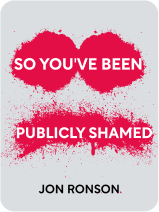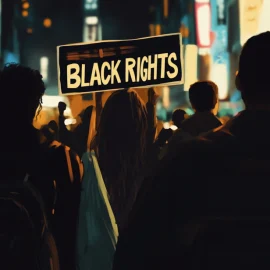

This article is an excerpt from the Shortform book guide to "So You've Been Publicly Shamed" by Jon Ronson. Shortform has the world's best summaries and analyses of books you should be reading.
Like this article? Sign up for a free trial here .
What was Lindsey Stone shamed for? And what happened to her after the incident?
In October 2012, Lindsey Stone was publicly shamed for posting a disrespectful photo on Facebook, where she posed behind the cemetery sign that read “Silence and Respect.” The photo became the centerpiece of Stone’s online presence for two years until an online reputation agent agreed to take her case pro bono to create her a new online identity.
Keep reading for the story of Lindsey Stone’s public shaming.
Lindsey Stone’s Lesson in Online Reputation
In October 2012, Lindsey Stone posted a disrespectful photo on Facebook, where she was pretending to scream and giving the middle finger beside a sign at Arlington National Cemetery that read “Silence and Respect.” The internet found the photo disrespectful and her public shaming lasted for over a year.
Lindsey Stone and her friend Jamie had a habit of taking stupid photos of themselves. For example, they’d mimic the poses of statues or smoke in front of no smoking signs. When Lindsey and Jamie encountered the Arlington sign on a trip with the residents to Washington, D.C., Lindsey posed in front of the sign, doing exactly the opposite of what it advised. Jamie posted the photo on Facebook and tagged Lindsey with her permission.
A few of their Facebook friends commented that the photo was tasteless or offensive. Stone responded to say that they were just goofing off like they did in their other photos and that they didn’t mean any disrespect. Jamie asked Stone about taking the photo down, but Stone thought it would be fine to leave it up.
Jamie’s Facebook settings weren’t private. A month after the photo was posted, someone found it and passed it around the internet. Stone never found out who started it, but suspected it might have been someone from work who didn’t like her or Jamie.
Immediate Aftermath
Shamers accused Stone of hating the military, made fun of her appearance, and sent her rape and death threats. A few people commented that the photo was just a joke and Stone’s life shouldn’t be ruined, but they were quickly shut down.
Stone apologized for the photo. However, someone created a Facebook page calling for her to be fired from her job with LIFE (Living Independently Forever), a residence for people with learning disabilities. 12,000 people liked the page and many people also emailed her employer directly. Lindsey was fired.
The media showed up at Stone’s house. Her father spoke to them and noticed that the cameras focused on his cigarette and dog, which had followed him out of the house when he’d opened the door. This focus made it seem like the media was trying to cast Lindsey’s family as smoking hillbillies with guard dogs.
Other Lindsey Stones got shamed as well—sixty other people with the same name lived in the US.
Long-Term Consequences
The photo became Stone’s entire internet presence and an iconic symbol of the enemy for military supporters, antifeminists, and right-wingers. One man even photoshopped it and turned it into wallpaper.
Stone became depressed and an insomniac, and isolated herself for almost a year. When she was ready to look for work again, no one responded to her applications. Eventually, someone offered her a caregiver job. She was terrified the new company would google her and debated telling them in advance of the interview who she was. She ultimately didn’t because once people get to know her, they aren’t angry about the photograph because they realize she’s a lot more than what the internet thinks of her.
Stone googled herself on Veterans Day in 2013. The photo had still dominated Google Image results and some ex-army people were writing about tracking her down and restarting the shaming.
16 Months Post-Shaming
Four months after Stone got her new job, she still hadn’t told anyone at work about the photo. She thought one of her coworkers might know because he made a comment about putting things up on the internet, but it was too vague for her to be sure. She lived with constant anxiety and stress because if anyone at work googled her name, the photo would come up, and she might get shamed all over again. Stone adored her new job and the children she worked with and didn’t want to lose it. Stone’s personal life was affected too—like Sacco, she hadn’t tried to date.
Ronson connected Stone with Reputation.com, who agreed to take on her case pro bono (it would normally cost several hundred thousand dollars) so that Ronson could observe the process as research for the book. Stone knew that she’d also have to appear in Ronson’s book, but her situation at the time was so uncomfortable that she thought removing the photo from the internet would be an improvement nonetheless.
Stone worked with Farukh Rashid to create a new internet presence. Initially Stone found the process entertaining, but it became existential—she had to ask herself who she really was and how to brand herself. When she described her five years working at Walmart as “soul-sucking,” Rashid asked her if she wanted to use that word. At first, she laughed, because she didn’t think that it could possibly offend anyone because it was true, but then she hesitated. The process ultimately involved presenting a watered-down version of herself—someone who liked Top 40 music and cats and travel but wasn’t as outspoken or playful.
20 Months Post-Shaming
By October 2014, the photo no longer dominated Google’s search results. It still appeared, but so did blog posts about traveling, new social media accounts, photos of Stone doing regular things, and photos of other Lindsey Stones. The reputation management process is an ongoing process, though, and Rashid calls Stone every week so she can approve Reputation.com’s latest content.

———End of Preview———
Like what you just read? Read the rest of the world's best book summary and analysis of Jon Ronson's "So You've Been Publicly Shamed" at Shortform .
Here's what you'll find in our full So You've Been Publicly Shamed summary :
- How public shaming can ruin people's lives
- Why public shaming isn't just a way to get corporations to do the "right thing"
- 6 strategies you can use if you're a victim of public shaming






